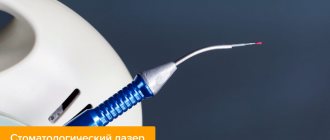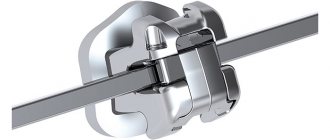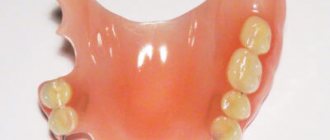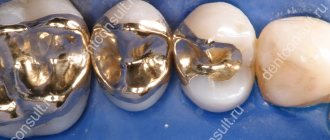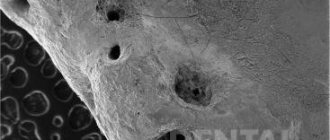Treatment Goals
During endodontic treatment, the dentist must achieve certain goals. Only after achieving them can you count on a quality result.
Main goals of treatment:
- Complete mechanical cleaning of dental root canals from damaged tissues, bacteria and the results of their reproduction;
- Complete closure of root canals in all directions.
Thanks to high-quality cleaning, the destruction of healthy dental tissues is stopped. Clogging the canals helps protect the roots from re-infection with bacteria and destruction.
Suitable materials are required for complete sealing. The seals must meet the following requirements:
- Do not cause irritation to surrounding tissues;
- Ensure tight sealing;
- Protect against bacteria and prevent their penetration into the root canal.
The most suitable materials for such purposes are gutta-percha (dense pin) and sealers (cement layer). When used together, they make it possible to obtain a hermetically sealed inert seal.
Gutta-percha is a unique natural material. Thanks to its homogeneous structure and thermoplastic properties, it is possible to obtain a homogeneous filling suitable for any shape of the root canal.
The sealer further enhances the strength of the filling by sealing the spaces between the walls of the root space and the gutta-percha.
The properties of the main materials of the filling allow it to perform the following functions:
- Complete sealing of the root and its branches;
- Matching the root canal configuration;
- Protection against bacteria;
- Creating a favorable environment for the regeneration of root tissues.
Advantages and disadvantages
Lateral condensation using gutta-percha is a fairly popular method for treating the root region of the tooth.
Has the following advantages:
- ease of execution;
- quality result;
- long-term effect;
- a small amount of sealer;
- complete filling of channels without voids and bubbles;
- plasticity of the material;
- minimum irritating effect;
- no shrinkage.
Flaws:
- during the process of condensation, the component presses on the walls of the root, which can lead to its fracture;
- in the presence of small branches, it is necessary to fill these areas only with the use of paste, since gutta-percha simply will not penetrate into them;
- the upper zone of the cavity is filled only with the rod, therefore, how well it will be sealed cannot be guaranteed;
- lateral canals are sealed only by using a sealer.
General idea of the methodology
The technique of vertical condensation of gutta-percha was originally described in 1967 by Shilder under the name "Softened Gutta-percha Technique". Today, this filling method is widely and successfully used throughout the world.
The essence of the method is to fill the root cavity with heated gutta-percha points with a minimal amount of sealer.
The main tools are pluggers , with the help of which gutta-percha is compacted at different levels of the root cavity.
Condensation of heated gutta-percha with a plugger occurs until it acquires the most accurate shape of the root cavity.
The whole process consists of two main stages:
- Filling the apical part of the canal with gutta-percha;
- Filling the middle and top parts.
The most important point in the filling process is the selection of the plugger and its working length. A tool that is too small will not provide sufficient condensation, and one that is too large can cause vertical root fracture due to excessive pressure on the walls.
The most suitable length for the smallest plugger is 5mm less than its working length. This will compact the gutta-percha in the root cavity and prevent the filling material from extending beyond the upper edges of the canal.
To control the quality of compaction of gutta-percha pins in the canal cavity, it is recommended to use an x-ray method.
The essence of using profiles in dentistry and instructions for their use.
Come here to learn more about the composition, properties and purpose of Atatsamite.
At this address https://www.vash-dentist.ru/lechenie/zubyi/plombyi/kornevyih-kanalov-metodom-lateralnoy-kondensatsii.html we’ll talk about filling using the lateral condensation method.
Types and methods of root canal obturation
There are two types of obturation of tooth root canals - permanent and temporary. The latter is necessary in the case of an inflammatory process in which it is impossible to place a permanent filling. A temporary filling is made of non-hardening material and can be installed for a short time, a maximum of several months; after the signs of inflammation disappear, a permanent filling is used. There are a large number of methods for permanent obturation of canals using gutta-percha pins. The most common of them include the following methods: obturation of thermoplasticized gutta-percha, lateral condensation, chemical softening of gutta-percha, thermomechanical condensation, standardized filling. Also, some clinical situations require combined methods of canal closure to obtain effective results.
Temperature control
Despite all its effectiveness, the method is quite difficult to use in cases of complex curvature of the root cavity. For such purposes, pluggers made of nickel and titanium can be used.
Initially, this method of condensing gutta-percha used a hot instrument, most often using a torch. This method of softening the material requires skill and dexterity.
This problem has now been solved using special electronic devices. Their use has greatly facilitated and improved the work of dentists.
Among the most popular devices are:
- Touch-n Heat;
- System-B;
- E&Q Plus;
- Obturation Unit.
These devices allow you not only to heat gutta-percha pins, but also to do it smoothly, and also to maintain a constant temperature in the canal cavity.
This helps avoid sealing errors that previously occurred due to insufficient temperature control.
The devices can also be used not only for vertical condensation, but also for other treatment methods in dentistry.
Materials for obturation of root canals
Intentional closure of the cavity is used to treat pulpitis or periodontitis when filling teeth. Obturation of the root canals is performed using special filling materials, which have a number of requirements. They have to:
- Possess antibacterial properties and low toxicity;
- Do not shrink;
- Have optimal curing time;
- Do not irritate the tissues surrounding the tooth;
- Fill the channel evenly and, if necessary, remove from it;
- Do not dissolve upon contact with tissue water.
Gutta-percha, used by most dentists for obturation of root canals, meets almost all of these requirements; it is a strong and at the same time flexible material obtained by coagulating latex. Since gutta-percha does not have an antimicrobial effect, it is used in combination with a sealer, which also has plastic hardening properties.
Using a pin and sealer
For vertical condensation with gutta-percha rods, it is recommended to use a non-standard conical pin as the main product. This rod is fitted into the root canal 1 mm less than its working length.
Once the correct pin size is selected, it should slide in and out of the hole with little force.
The filling method consists of the following steps:
- The walls of the root cavity are lubricated with sealer using a paper or gutta-percha point;
- The excess length of the main pin is cut off with a heated tool;
- Rotational movements of a large plugger condense the gutta-percha pin to the apical zone;
- It is important that the plugger does not apply excessive pressure to the side walls of the root canal, which can lead to its destruction;
- The heated plugger softens the pin and at the same time helps remove excess material;
- Keeping the plugger at a certain temperature allows the pin to remain in place when the tool is removed;
- Compaction in the apical zone is made with a smaller instrument;
- The procedure continues until the smallest plugger reaches a depth less than 5 mm from the working length of the root cavity;
- The remaining part of the canal is filled with gutta-percha pins, which are thermally softened and condensed by pluggers until completely filled.
Advantages and disadvantages
Filling the root cavity using vertical condensation has several advantages:
- The ability to completely fill all lateral branches of the dental root. No other method can provide such quality and sealing of the entire root canal;
- Minimum sealer consumption. It is used only to lubricate the walls, while in other methods it fills the spaces between the pins;
- Uniformity of the filling. Only thermoplastic gutta-percha points can provide a homogeneous, durable and airtight filling.
Like any other filling method, vertical condensation also has its disadvantages:
- High level of complexity of the procedure;
- There is a possible risk of gutta-percha leaving the upper edges of the root cavity.
To obtain an effective result, compliance with all technologies and the skill of the doctor is required.
Let's consider effective methods of obturation of root canals and the technique of carrying out a standard procedure.
In this publication we will talk about the purpose of the filling material Estelite Asteria.
Here https://www.vash-dentist.ru/lechenie/zubyi/plombyi/chto-takoe-retrogradnoe.html read what is included in the set of tools for retrograde root canal filling.
Indications and contraindications
The procedure has a wide range of indications. These include simple clinical cases when treatment of the root part of the tooth is required, and manipulation against the background of complicated inflammatory processes, pathologies of periodontal tissue, and granulosa formations.
The technique also has its own contraindications, some of which are absolute, and some simply make the procedure ineffective:
- excessively narrow channel;
- curvature of the tooth root structure;
- pathology of the cavity shape;
- iatrogenic formations;
- apical destruction;
- open apex.
The purpose of obturation of root canals with gutta-percha and the instruments used.
This is interesting: Treatment of tooth pulpitis - a biological method
Continuous wave option
A variation of vertical condensation is the “continuous wave” method. This filling method requires a System B device and special pluggers.
The method consists of two stages:
- At the first stage, the apical part of the canal is filled. The main pin is selected, installed in the canal, and then cut in the middle with a plugger heated to 200⁰C and condensed in the apical direction;
- The second stage is to completely fill the channel. A pin of the same size is taken and condensed in the same way with a plugger heated to 100⁰C. The procedure is repeated until complete closure.
The advantage of this method is its simplicity and convenience compared to vertical condensation.
Minor concerns were caused by the temperature of the plugger being too high. But experience has shown that a short period of time exposed to temperature has no effect on the apical tissues.
Preparation and course of action
All basic and preparatory actions do not fall into the category of complex manipulations. Everything is done quite simply and quickly. Moreover, the technique is classified as a highly effective method of treatment.
Master pin selection
After the root canals are expanded and the working area is ready, the doctor remembers the size of the last pin with which he reached the apex. Gutta-percha is taken in the same size.
A gap of 1 mm from the apex is made on the rod - this is necessary so that the material does not go beyond the permissible limits. There are several options for fitting the composition into the root canal of a tooth:
- visual – a stopper is installed on the gutta-percha 0.1 cm smaller than the pin. The paste is injected into the cavity and determined by eye whether its further advancement is possible.
If so, then a wide cavity or unintentional perforation during the dentist’s actions is diagnosed. In this case, the gutta-percha is shortened by about 0.2 cm.As an alternative, select a larger model so that it can be securely fixed in the root zone of the organ;
- to the touch - the initial stage of action is similar to the method discussed above.
When, as the rod is inserted, approximately 3 mm remains to the apex, the specialist should feel difficulty in introducing the composition, and when trying to pull the pin out of the hole, some resistance is felt. If such signs occur, it means that the size of the model is selected as correctly as possible. If no tactile result is observed, shorten it or take another larger device; - using X-ray equipment is the most reliable way.
It is used after the previous two have already been done. The study is carried out with already implanted gutta-percha, as it is characterized by excellent radiopaque properties. Upon completion of the manipulation, a mark is placed indicating the required length.
Selection of side seal
This element in dental practice is called a “spreader”. The required length is fixed at 0.1 - 0.2 cm less than the master pin.
The value must be taken similar, or an order of magnitude greater, so as not to go beyond the apex. Then follows the first phase of filling the tooth canals using the method discussed in the article.
Filling with paste
The next step is to fill the root canal with endosealant. This can be done using a K-file, K-reamer or channel filler. The paste should be injected up to the apical foramen and distributed evenly over the walls.
It is important not to overdo the amount of material and not fill the channel completely. It is enough to fill one portion with channel filler, and 2-3 portions with hand tools.
Introduction of the main pin
Next, you need to insert the pre-selected main pin. To do this, it is covered with filling material and placed in the root cavity.
At this stage it is important to take everything slowly. To eliminate possible air bubbles, the doctor uses rotational movements when inserting the pin.
Side seal
At this stage, the previously selected spreader is used. It is inserted into the hole with rotational movements to a depth of 1-2 mm less than the working length. At this point, the pin is firmly attached to the canal wall.
The spreader must be fixed in this position for a minute so that it has time to take the desired shape. Excessive force and excessive spreader pressure on the pin may cause a crack in the bore.
After this, the spreader is removed, and if necessary, a second and subsequent pin is inserted, which are sealed in the same way.
The action is repeated until the canal cavity is completely filled. In some cases, up to 5 pins may be required.
Removal of excess and control
After filling the channel, it is necessary to trim the ends of the pins that protrude above the top edge of the hole. This is usually done using a heated instrument - a probe or a smoother.
The remaining filling paste is removed with cotton balls. To check the filling density of the canal, an X-ray of the tooth is taken.
Applying a temporary filling
It is advisable to carry out this stage to check the condition of the canal during the first days after the procedure. A temporary filling is much lighter and easier to remove if any complications arise.
This is interesting: Dental treatment for pregnant women: what you need to know and do?
The final stage
If there are no complications or problems with the filled root canal, a permanent filling can be placed. Here, various polymer or composite materials can already be used at the patient’s choice.
The video introduces the lateral condensation technique.
Injection method
There is also an injection version of the method. This method consists of filling the root cavity with heated gutta-percha, which is injected using a special instrument under pressure.
To use the injection method, equipment is required, which includes a gun and special gutta-percha sticks.
These sticks are heated in a gun until they become plastic and are inserted into the root cavity using a flexible needle. The needle size is selected individually depending on the size of the root canal. After this, the gutta-percha is compacted vertically.
The injection method is suitable for canals with wide cavities or complex shapes, with resorption or incomplete root formation.
Applied systems
The injection method involves the use of several systems:
- Obtura;
- BeeFill;
- E&Q Plus;
- Obturation Unit.
The Obtura, BeeFill and E&Q Plus systems involve the use of special gutta-percha sticks, which are included in the kit and are heated in the gun chamber. The material can be heated to a maximum of 65⁰C and remain in this state for up to 3 minutes.
Next, gutta-percha is introduced into the canal using a cannula, which is also included in the kit. Different systems use different cannulas in size and type.
In the Bee Fill and Obturation Unit systems, the gutta-percha material is supplied in cartridges that are pre-filled and have cannulas.
Pros and cons of the injection method
The advantages of the injection method include:
- Better adaptation of gutta-percha to the walls of the root cavity , which is achieved as a result of filling with heated material;
- Complete filling of all branches of the root canals due to the plasticity of heated gutta-percha.
Among the disadvantages of this method are:
- Control of the depth of needle insertion is required to avoid incomplete filling;
- Compliance with heating and feeding technologies for gutta-percha in systems is required;
- Gutta-percha may shrink after cooling;
- There is a possible risk of gutta-percha leaving the upper edge of the root cavity.
The video shows a diagram of vertical condensation using the example of endodontic treatment of an incisor.
Obturation of root canals
Artificial closure of the lumen of a cavity organ is typical for such a field of medicine as dentistry. It is carried out when filling teeth in the case of treatment of periodontitis or pulpitis. Root canal obturation can be of two types: permanent and temporary. This is done using special filling materials. In this case, the most rational is the use of gutta-percha, that is, latex processed in a certain way. As a rule, this material does not cause allergies, and its ability to expand when heated allows it to accurately fill the required cavity. Gutta-percha is used in combination with a paste-like substance - sealer.
Temporary obturation of the canals is carried out in cases where it is impossible to place a permanent filling due to the presence of a local inflammatory process. This may be indicated by pain during percussion or swelling in the tooth area. Obturation of the canals in this situation requires the use of plastic, non-hardening materials; they must, moreover, have certain medicinal properties. The time for which such materials are installed varies from several days to several months. After the symptoms of inflammation disappear, a permanent filling is installed.
conclusions
Since its inception, many microscopic studies have been carried out to test the effectiveness of the vertical condensation method.
Their results proved that this method allows for complete and high-quality canal filling. This is especially true for branched channel openings.
The popularity of the method lies in its cost-effectiveness and speed of implementation. The doctor’s honed skills make it possible to eliminate almost all shortcomings.
If you find an error, please select a piece of text and press Ctrl+Enter.
Tags gutta-percha pins filling
Did you like the article? stay tuned
Previous article
Profiles in dentistry - get right to the root
Next article
Subtleties of using Metapaste for temporary filling of tooth canals
What affects the quality of filling?
Root canal filling is a rather responsible procedure that requires a professional approach.
The quality of the filling is influenced by the following factors:
- the most accurate determination of the depth and shape of the channel;
- clogging the hole to the very top, since even the slightest voids or gaps will provoke the accumulation of bacteria in them and the development of the inflammatory process;
- high-quality mechanical processing of the canal walls and its expansion to the required dimensions.
The Berezka dental clinic employs highly qualified specialists who are able to carry out filling procedures of any complexity at a high level of quality.
Lateral condensation (cold compaction)
Most dentists understand cold consolidation as synonymous with lateral consolidation. This technique is applicable to most canals and requires the creation of a uniform cone shape with an apical taper in healthy dentin. In this technique, the gutta-percha master pin is selected according to the size of the last reaming instrument that traversed the canal to its full working length. A common compaction tool is a spreader, which comes in a variety of sizes and the choice depends on the size, length and curvature of the canal. A master pin with sealer is placed in the canal and compacted with a cone-shaped metal spreader in a vertical or lateral direction. The space created by the spreader is filled with additional smaller or additional pins, which are also compacted until the canal is filled.
Selecting a master pin.
The gutta-percha master point is selected based on the final size of the formed root canal apex. If standardized K-files or H-files were used to prepare the canal, and the canal is free of filings, the master pin should match the working length or be slightly shorter (0.5 mm). The pin is clamped in tweezers approximately at the level of the working length. The correctness of determining the length of the pin is confirmed if, when the pin is inserted into the canal, it begins to contact the canal walls within 1-3 mm from the apex, is conveniently located at the measured depth, resists advancement beyond the apical constriction under pressure, and demonstrates slight resistance when withdrawn. If this does not happen, the pin can be carefully trimmed with sharp scissors, however, it is preferable to do this with a scalpel. It is possible to shorten the pin by 0.5-1 mm until the required length is obtained. If necessary, calibration templates can be used to facilitate the preparation of the master pin. The final position of the master pin in the canal can be marked by notching it at the level of the incisal or occlusal reference point with a sharp instrument or by squeezing the pin with tweezers. Subsequently, the position of the pin is checked radiographically and assessed according to the following criteria:
1. Does the position of the cone correspond to the working length (a position 0.5 mm shorter than the working length is allowed). Is the pin positioned correctly in the apical 1-3 mm, and is there space lateral to the master pin at the border of the apical and middle third of the canal for the sealing procedure?
2. If the master pin position does not reach the required depth, it may happen due to the following reasons:
- The apical portion may become clogged with dentin debris as a result of inadequate cleaning. These filings should be removed using a fine file and copious irrigation before refitting the master pin (more details in Chapter 8).
- There may be a ledge in the channel that is shorter than the working length. In this case, every effort must be made to re-pass the channel to its full depth.
- There may be a bend in the canal that is not visible on a 2D radiograph. The anatomy of the canal must be analyzed. Pre-bending the gutta-percha before insertion can facilitate its penetration to the full length of the canal.
- The master pin may be too large, in which case it should be replaced with a smaller one. Sometimes pins taken from the same box may have a different taper or a different shape. Using sizing tools helps in this situation.
- The most likely reason preventing the placement of the pin to its full depth is insufficient three-dimensional formation of the canal in the apical and middle third. In these cases, the canal must be reshaped to achieve full length master pin placement.
3. If the pin corresponds to the working length, is conveniently located in the canal, but does not have free space in the lateral areas at the level of the upper two-thirds of the canal, the canal shape should be changed before obturation. If we do not see these spaces on the radiograph, it is an indication that the canal is not formed properly to allow adequate spreader penetration during the obturation process. This usually results in poor placement and sealing of the pins in the prepared apex. 4. If the master pin exceeds the working length, it can be cut (as described above), or a larger diameter pin can be selected. However, a larger pin can have a greater taper, which minimizes the side spaces required to accommodate the spreader. Also, if you select too large a pin in a curved canal, the pin may get stuck prematurely due to the narrowing of the canal in the bend area. 5. If the pin corresponds to the working length, is conveniently located in the canal, and free spaces are determined along the cone in the apical part, but there are none in the upper two-thirds of the canal, this means that either the cone is of the wrong shape and size, or the upper two-thirds of the canal are not properly formed. 6. If a wavy or S-shaped pin is detected radiographically, then this pin is too small for this canal and it is necessary to take a larger pin.
Once the master pin is fitted, it is removed from the canal and placed in a sterile 70% alcohol solution or 2.5-5% sodium hypochlorite solution. The canal is then dried using paper absorbents. If the smear layer has been removed, certain solutions are used at this time (read about removing the smear layer here). Some authors recommend removing all residual fluid from the canal by rinsing the canal with 95% ethyl alcohol or 99% isopropyl alcohol. The alcohol is left in the canal for 2-3 minutes and then removed with sterile paper points.
Before applying the sealer, it is necessary to select a compaction tool. Sterile (or disinfected) caulking instruments are used during the cleaning and canal shaping stage to determine whether the required canal shape has been created to allow the instrument to immerse to its full working length.
Lateral compaction is carried out using a manual or finger spreader. The selected instrument must enter to its full working length without getting stuck in the empty channel. That means
the need to select both the appropriate length and taper of the compaction tool based on the shape, size and curvature of the canal. In tortuous channels, stainless steel instruments can be pre-bent before use, or NiTi instruments can be used. Whenever possible, mark the working length on the tool with a rubber stop. This is not necessary if the metal tool is graduated
After selecting an instrument to seal and dry the canal, a sealer is introduced into the root canal. Effective distribution of the sealer within the root canal is the basis for achieving the best possible obturation of the root canal. Various methods of adding sealer have been tried. including spiral channel fillers, files, reamers, gutta-percha master points and ultrasonic instruments. Application using a master pin is considered optimal. In larger canals this procedure may have to be repeated. For lateral compaction, the sealer must be placed at the working depth of the canal. Complete filling of the canal with sealer should be avoided, because the sealer is additionally introduced into the canal during the compaction process on additional gutta-percha pins.
Master pin placement.
Slow insertion of the master pin is necessary to ensure uniform distribution of the sealer, release of air bubbles, lateral and coronal movement of the sealer, and to minimize displacement of the sealer beyond the apical foramen. If there is any doubt about the position of the pin and sealer, a radiograph should be taken. If necessary, the master pin can be removed and repositioned to its correct position.
Master pin seal.
After placing the master pin, the spreader is inserted along it without force; forceful advancement can lead to a vertical fracture. The length of the spreader is set to 0.5 mm shorter than the working length of the channel. As discussed previously, failure to achieve this length may be due to improper fit of the master pin at the formed apex. Once the spreader reaches the desired depth, the gutta-percha master pin is compacted vertically and laterally by moving the tool in a 180° arc. During these movements, the pin is pushed toward a specific canal wall until space is created laterally for additional gutta-percha pins.
Placement of additional pins.
Additional pins are selected based on the size of the spreader being used, the size of the canal, and the space created in the canal. Additional pins are lightly coated with sealer and inserted into the space created by the compaction tool. The inability to advance the additional pin is due to one of the following reasons:
• The extra pin is too long or has the wrong taper for the space created. • The spreader is too small and does not fit with the extra pin. • The master pin seal was not sufficient to create space for additional pins • The channel is not tapered enough to accommodate both the spreader and the additional pin.
Completion of obturation and tactics in relation to the pulp chamber.
The canal is filled with gutta-percha pins until the spreader penetrates only 2-3 mm into the canal opening. Then, using a heated instrument or special heating devices, the ends of additional gutta-percha pins are cut off and the gutta-percha in the upper part of the canal is softened. The gutta-percha is then vertically compacted with a plugger to adapt the coronal gutta-percha to the canal walls and improve the coronal sealing of the canal. The plugger used for this purpose should not be embedded along the canal wall. To do this, before obturation it should be tried on in the canal. Spreaders are not heated or used to remove gutta-percha because none of the modern spreaders are made of metal designed to be heated. Excavators can be used similarly for this purpose, although they are also not designed for heating (their main purpose is to effectively remove carious tissue and pulp tissue). Once the gutta-percha has been compacted from above, the pulp chamber is cleaned with a cotton ball soaked in alcohol to remove any remaining sealer and gutta-percha fragments. A temporary restoration is performed, and in some rare cases, space is immediately created for the intraradicular pin and the permanent restoration begins.
The final radiograph is taken without a rubber dam in such a projection that the obstruction of each canal is clearly visible.

